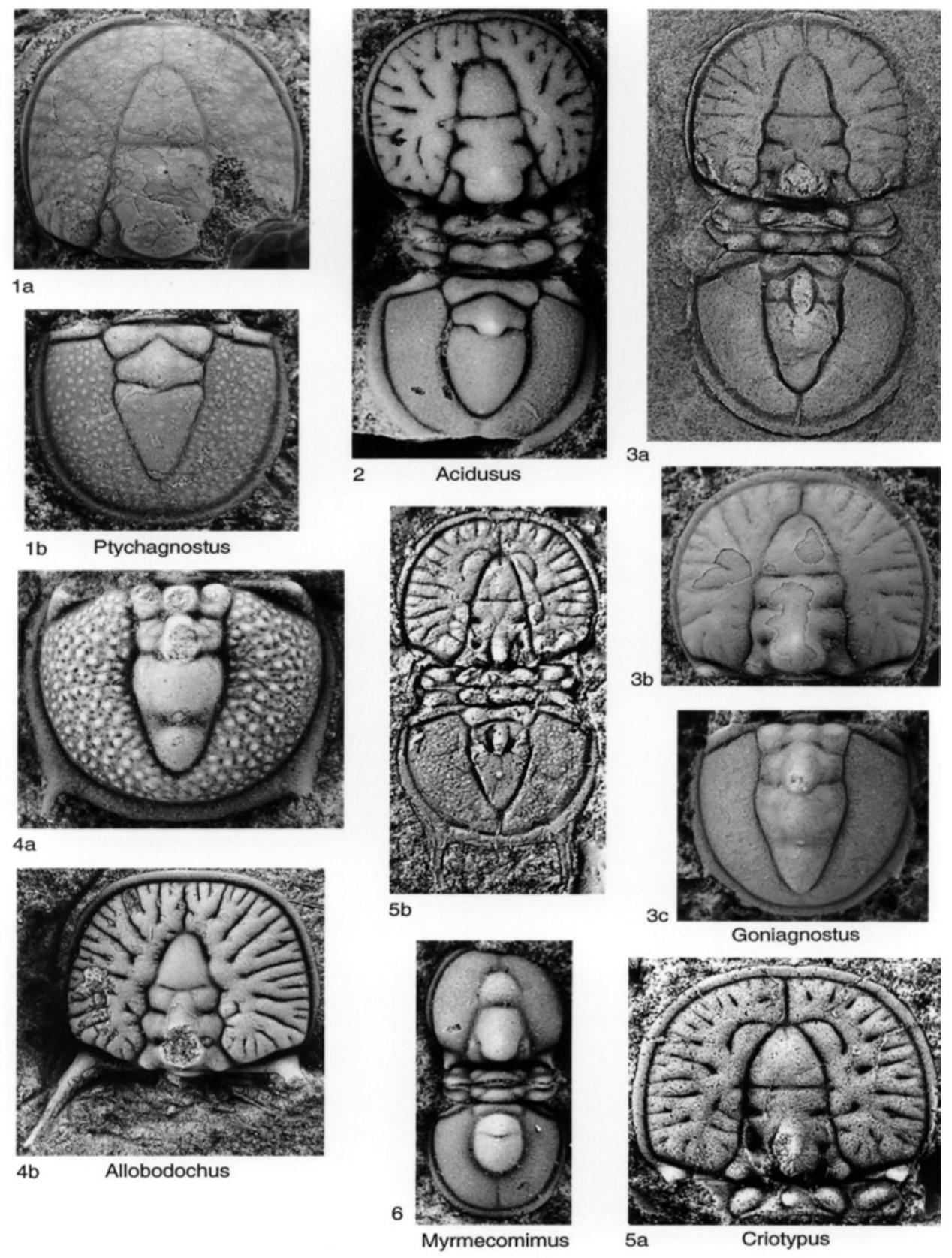Welcome to the Treatise on Invertebrate Paleontology!
Please enter a genera name to retrieve more information.

Neoagnostus
Classification
Phylum:
Arthropoda
Class:
Trilobita
Order:
Agnostida
Superfamily:
Agnostoidea
Family:
Diplagnostidae
Formal Genus Name and Reference:
Neoagnostus KOBAYASHI, 1955, p. 473
Type Species:
N. aspidoides, OD, holotype (KOBAYASHI, 1955, pl. 7, fig. 5), 12745, GSC, Ottawa
Images
(Click to enlarge in a new window)
Fig. 233,2a. *N. (N.) aspidoides, ?Lower Ordovician (“Symphysurina fauna”), Canada (Harrogate, British Columbia); holotype, cephalon, GSC 12745, ´7 (Shergold, 1977, pl. 16, Fig. 6).—— Fig. 233,2b,c. N. (N.) bilobus (SHAW), uppermost Cambrian (Missisquoia Zone), USA (Highgate Falls, Vermont); b, paratype, cephalon, USNM 124467, ´16; c, holotype, pygidium, USNM 124468, ´12.5 (Shergold, 1977, pl. 16, Fig. 7–8).
Synonyms
Geographic Distribution
Age Range
Beginning Stage in Treatise Usage:
Upper Cambrian
Beginning International Stage:
Guzhangian
Fraction Up In Beginning Stage:
50
Beginning Date:
498.75
Ending Stage in Treatise Usage:
Lower Ordovician
Ending International Stage:
Floian
Fraction Up In Ending Stage:
100
Ending Date:
471.26
Description
Spectaculate, partially effaced to en grande tenue, with generally wide borders and subdeliquiate to deliquiate border furrows, acrolobes weakly constricted, cephalon and pygidium frequently subquadrate. Cephalon with variably developed median preglabellar furrow, generally small, rhomboid anterior lobe, variably defined, V-shaped F3, chevronate F2 behind anterolateral lobes of posterior glabellar lobe, anterolateral lobes close together or meeting sagittally. Pygidium with third annulation in anterior part of axis, weakly to strongly deuterolobate, with retral posterolateral spines. Upper Cambrian-Lower Ordovician.
References
Museum or Author Information
Classification
Phylum:
Arthropoda
Class:
Trilobita
Order:
Agnostida
Superfamily:
Agnostoidea
Family:
Diplagnostidae
Formal Genus Name and Reference:
Neoagnostus KOBAYASHI, 1955, p. 473
Type Species:
N. aspidoides, OD, holotype (KOBAYASHI, 1955, pl. 7, fig. 5), 12745, GSC, Ottawa
Images
(Click to enlarge in a new window)
Fig. 233,2a. *N. (N.) aspidoides, ?Lower Ordovician (“Symphysurina fauna”), Canada (Harrogate, British Columbia); holotype, cephalon, GSC 12745, ´7 (Shergold, 1977, pl. 16, Fig. 6).—— Fig. 233,2b,c. N. (N.) bilobus (SHAW), uppermost Cambrian (Missisquoia Zone), USA (Highgate Falls, Vermont); b, paratype, cephalon, USNM 124467, ´16; c, holotype, pygidium, USNM 124468, ´12.5 (Shergold, 1977, pl. 16, Fig. 7–8).
Synonyms
Geographic Distribution
Age Range
Beginning Stage in Treatise Usage:
Upper Cambrian
Beginning International Stage:
Guzhangian
Fraction Up In Beginning Stage:
50
Beginning Date:
498.75
Ending Stage in Treatise Usage:
Lower Ordovician
Ending International Stage:
Floian
Fraction Up In Ending Stage:
100
Ending Date:
471.26
Description
Spectaculate, partially effaced to en grande tenue, with generally wide borders and subdeliquiate to deliquiate border furrows, acrolobes weakly constricted, cephalon and pygidium frequently subquadrate. Cephalon with variably developed median preglabellar furrow, generally small, rhomboid anterior lobe, variably defined, V-shaped F3, chevronate F2 behind anterolateral lobes of posterior glabellar lobe, anterolateral lobes close together or meeting sagittally. Pygidium with third annulation in anterior part of axis, weakly to strongly deuterolobate, with retral posterolateral spines. Upper Cambrian-Lower Ordovician.
